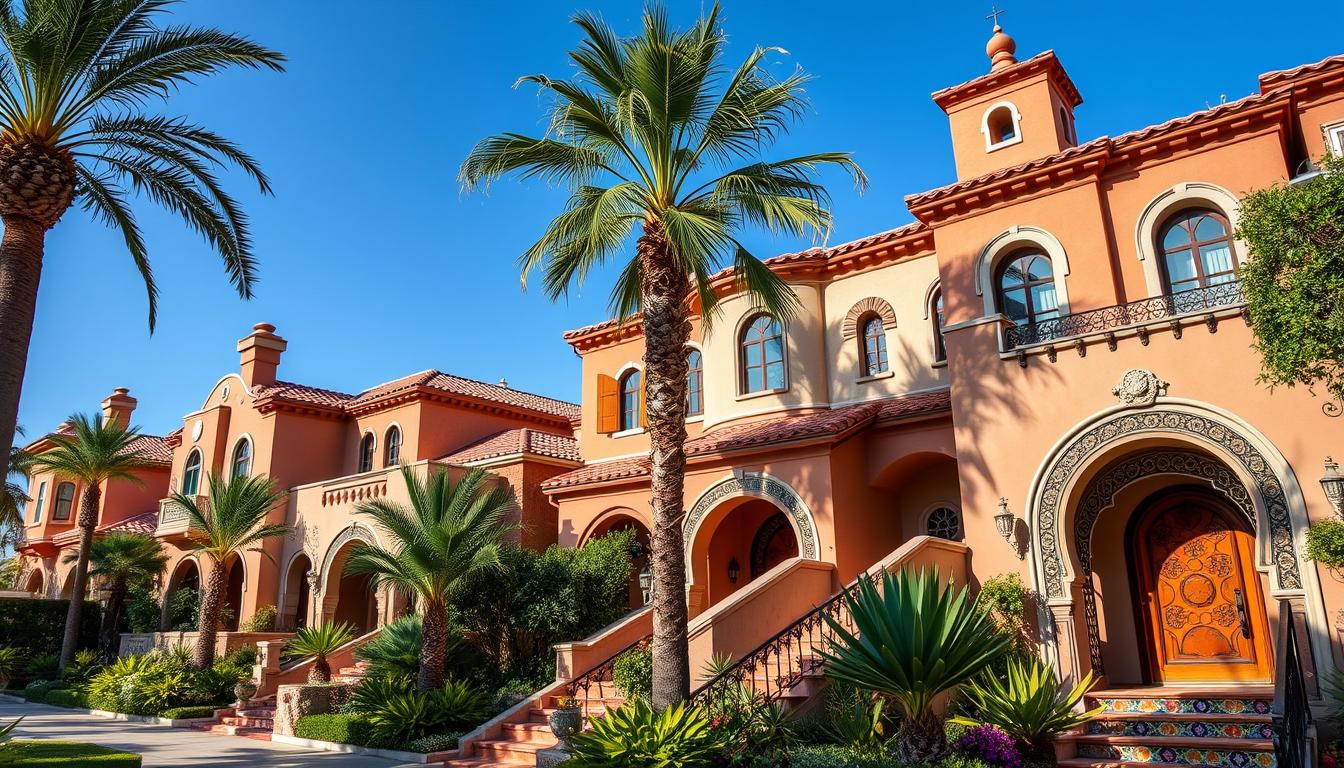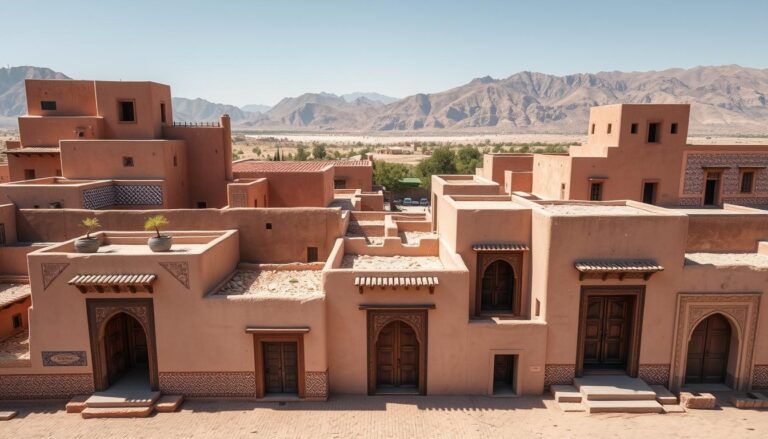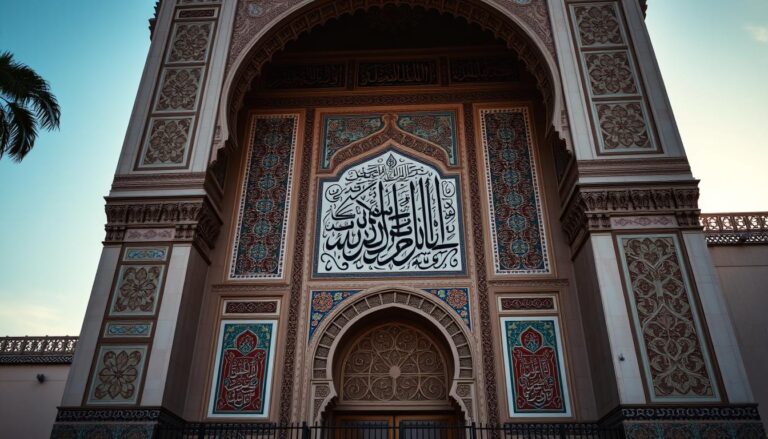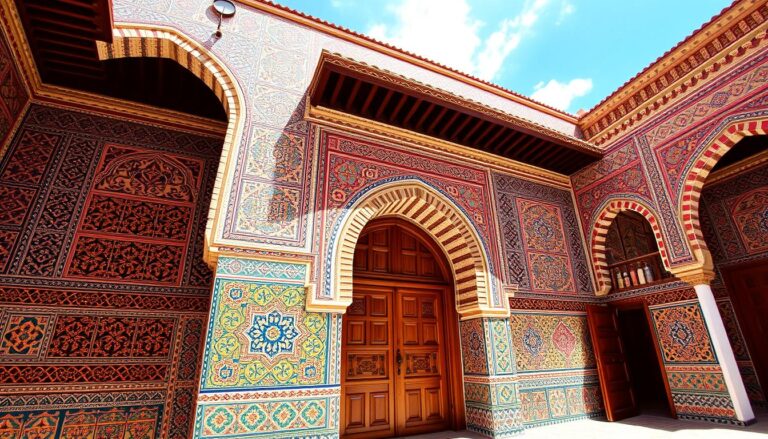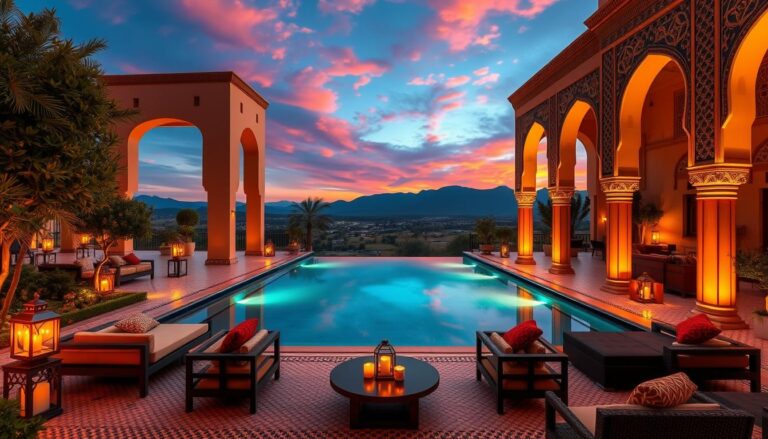You don’t have to travel to Morocco to experience its fabulous riads. Instead, head to Palm Desert, California. There, a Moroccan-inspired mansion named Casbah Cove is for sale for $18 million. It’s the most expensive home in Coachella Valley.
The seller is Howard Panes, a successful entrepreneur who moved to Florida. Renowned architect Gordon Stein designed the home with the original owner. It took over five years to complete, from 2006 to 2011.
More than 20 Moroccan artisans from Fez were flown in to work on the home. They installed handmade tiles and created intricate plasterwork. This work is seen in several rooms and the central courtyard.
Key Takeaways
- Moroccan-inspired mansions are increasingly popular in the United States, with one such home in Palm Desert, California, listed for $18 million.
- The Casbah Cove mansion features authentic Moroccan craftsmanship, including handmade tiles and intricate plasterwork installed by artisans from Fez.
- The home boasts a range of unique amenities, such as a Moroccan-style hammam, a 20-seat hookah lounge, and a retractable glass ceiling over the central courtyard.
- Moroccan design and architecture are gaining popularity in America due to the influence of a global economy and a growing appreciation for diverse cultural influences.
- The Casbah Cove mansion showcases the blend of Moroccan and modern elements that are captivating homebuyers and designers across the country.
Casbah Cove: A Moroccan-Inspired Mansion in Palm Desert
In Palm Desert, California, there’s a stunning Moroccan-inspired mansion called Casbah Cove. It’s in the Bighorn Golf Club and covers 16,800 square feet. This place shows how Moorish architecture meets modern luxury, giving a peek into Moroccan decor and Moroccan interior design.
Authentic Moroccan Craftsmanship
The detail in Casbah Cove is amazing. The owner brought over 20 Moroccan artisans from Fez. They put in the beautiful Moroccan tile patterns and Tadelakt plaster that cover the home. It’s a perfect mix of Moroccan motifs and Moroccan-style homes in America, showing off Moorish architecture.
Courtyard Living with Modern Amenities
The courtyard at Casbah Cove is a peaceful spot with a star-shaped fountain, like the Riads in the US. Rooms open right onto this area, making indoor and outdoor spaces feel connected. There’s also a unique glass ceiling that opens up, costing $900,000, to enjoy the courtyard’s beauty.
Casbah Cove combines traditional Moroccan-style homes in America with today’s comforts. It has everything from a 75-foot lap pool to a wine cellar that keeps wine at the perfect temperature. This mansion shows the owner’s vision and the lasting charm of Moroccan decor and Moroccan interior design.
Moroccan-style Homes in America
The American Riad Project in Detroit
In America, Moroccan-inspired homes are gaining popularity. The American Riad in Detroit’s North End is a prime example. It’s a project that combines housing, skill-sharing, and public art to revitalize the community.
The American Riad is a multi-year project in Detroit. It aims to rebuild a corner of Oakland Avenue and Euclid Street. The project includes a traditional Moroccan-style riad – a home with an interior courtyard.
This courtyard will be filled with art, gardens, and public space. It’s designed for gatherings, performances, and workshops. The project received a 2017 Knight Arts Challenge Detroit grant to fund it.
The project involves renovating a 12-unit building and adding two single-family homes. It also includes an edible garden in the courtyard. Legal protections will ensure affordability for residents.
Workshops on DIY water filtration and woodworking are part of the project. They aim to promote workforce development training and community building. The American Riad has become a center for educational events, attracting people from all over.
“The American Riad project applies theories on community identity and cultural philosophy in architecture and design to Detroit, particularly focusing on promoting togetherness and community interaction.”
Moroccan design elements like rich colors, intricate tilework, and arched doorways are used in the project. These elements create a vibrant and welcoming atmosphere. The central courtyard, a key feature of riad architecture, encourages indoor-outdoor living and community gatherings.
The American Riad is a testament to the appeal of Moroccan-style homes in America. It blends cultural influences and community-driven design to revitalize a Detroit neighborhood.
Recreating the Magic of Marrakech
Marrakech, in the heart of Morocco, has drawn designers and architects from everywhere. In April, a team from Atlanta, including designer Beth Webb, visited Marrakech. They were inspired by the city’s Moroccan-style homes, Moorish architecture, and decor.
Elements of Moroccan Design
The designers loved the Moroccan tile patterns, grand arches, and courtyard homes, or Riads. They wanted to bring Marrakech’s magic to their homes in the US. They used Moroccan motifs and Tadelakt plaster to do so.
They chose rich colors like siena and terracotta, along with vibrant blues and ambers. Lighting was key, using Arabic copper lamps, wrought iron, and wooden fixtures for warmth.
Geometry and patterns were big, with Moroccan tiles and shapes like polygons. Comfortable cushions and Berber carpets made the spaces cozy. Carved mirrors added to the Moroccan feel.
“The trip to Marrakech was a true feast for the senses, and we’re thrilled to be able to bring the magic of this incredible city back to our homes and projects in the United States,” said Beth Webb, the Atlanta-based designer.
Preserving Community and Affordable Housing
In Detroit’s heart, the American Riad project aims to keep community ties strong. It creates affordable Moroccan-style homes in America. This effort fights social isolation and keeps the city’s neighborhoods’ cultural essence alive.
The project starts with renovating a 12-unit building and adding two single-family homes inspired by Moorish architecture. The building, called “the Row,” will have retail on the ground floor and 6 units upstairs. It will also have a courtyard with an edible garden and hopes for a micro-orchard in a nearby lot.
To keep the project true to its community focus, the team is trying to get funding for Syrian architect Marwal al-Sabouni. Her work on Moroccan design and philosophy fits perfectly with their vision.
“The slow pace of the project creates unique opportunities for community engagement and input in urban development,” says a collaborator on the project.
The American Riad project is more than just building homes. It’s about keeping the community’s history and identity alive. By using Moroccan motifs and tile patterns, the team wants to give residents a sense of belonging and cultural connection.
The project’s use of Courtyard homes, Tadelakt plaster, and Arched doorways shows how Moroccan decor can fit into urban renewal. By saving historical buildings and involving the community, the American Riad project is a beacon of how Moroccan design can enhance urban areas.
Moroccan-style Homes in America: Blending Cultures
In Detroit’s North End, the American Riad project is more than just Moroccan architecture in the U.S. It celebrates the community’s diverse culture. The project combines Moroccan riad traditions with the area’s creative vibe.
The American Riad project got a 2017 Knight Arts Challenge Detroit grant. This shows it’s valued in the local arts scene. It includes renovating a 12-unit building and adding two single-family homes. These homes aim to offer affordable housing for the community.
Workshops from Indonesia and Morocco have taught skills like DIY water filtration and woodworking. These workshops help local residents and students. They show the value of diverse influences in Moroccan-style homes in America.
“The project emphasizes the importance of communal spaces and public art in fostering community interactions and unity, as well as highlighting cultural programming and outreach initiatives.”
The team wants to work with Syrian architect Marwal al-Sabouni. He will design the riad complex, focusing on community identity. This mix of global and local influences is the project’s core vision.
The American Riad project isn’t about introducing Islam to Detroit’s North End. The area already has a strong Black American Muslim history. Instead, it aims to bring people from different backgrounds together. It shows the beauty of Moroccan-style homes in America and the strength of cultural collaboration.
Conclusion
Moroccan-style homes in America are truly captivating. They show the lasting impact of Moorish architecture and design. Homes like the Casbah Cove mansion in Palm Desert and the American Riad project in Detroit mix old Moroccan styles with new features.
The homes feature bright colors, detailed tile patterns, and carved wood furniture. These elements bring a touch of North Africa to homes, drawing in both homeowners and design fans.
These projects help keep housing affordable, share skills, and bring cultures together. They’re changing neighborhoods and bringing Marrakech’s magic to the US. The use of natural materials and the work of skilled designers make these homes authentic and green.
More people are drawn to Moroccan decor’s bold, dramatic look. This style is becoming more popular in homes across the country.
Moroccan-style homes in America offer a special mix of old culture and new living. With their grand doorways, peaceful courtyards, and Tadelakt plaster, they’re a true inspiration. As this trend grows, it will continue to delight and inspire homeowners everywhere.
Source Links
- Home of the Week: This Magnificent Moroccan-Inspired California Estate Can Be Yours for $18 Million
- The Allure of Morocco – Atlanta Homes and Lifestyles
- Home of the Week: This $16 Million Moroccan-Style Mansion Brings Old Marrakech to the California Desert
- Casbah Cove: Luxury Moroccan riad in Palm Desert
- Explore a Moroccan Riad-Style Mansion in Palm Desert Seeking $16.1M
- This Moroccan-style housing and community space hopes to bring people together in the North End
- Moroccan Interior Design 101 | Amity Worrel & Co.
- Moroccan Style: How to Add Moroccan Interior Design to Any Home
- Inspiration Hunting: Marrakesh
- Our villas: Inspiration to decorate in the Moroccan style [Interview with Naima Abidin]
- Builders of Hope Rolls Out Anti-Displacement Toolkit to Keep Legacy Residents in Their Homes – CandysDirt.com
- Inspired by Islamic Architecture, Ghana ThinkTank Brings Community Space to A Corner of Detroit’s North End With Art | Creative Capital
- An “American Riad” in Detroit
- Pool Spa Moroccan Oasis Mia Riad Joshua Tree – Homestead Modern, LLC
- Mastering the Moroccan Interior Design Style
- Moroccan-Inspired Style – Galavante (Travel & Lifestyle Website)

The Editorial Team is a passionate group of Morocco enthusiasts dedicated to sharing the beauty, culture, and wonders of this captivating country. With diverse backgrounds and a deep love for travel, we strive to bring you engaging and informative content that inspires your Moroccan adventures. From uncovering hidden gems and sharing local insights to exploring mouthwatering cuisine and showcasing the vibrant lifestyle, our team is committed to providing you with valuable resources and exciting stories that enhance your exploration of Morocco. Join us on this journey as we celebrate the rich heritage and unforgettable experiences that make Morocco truly special.

